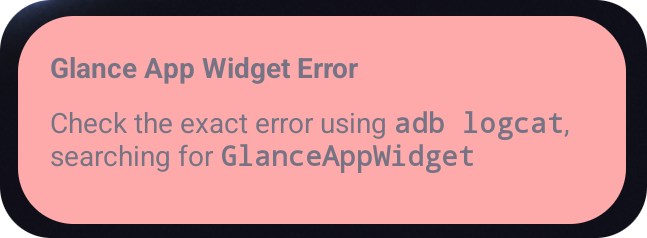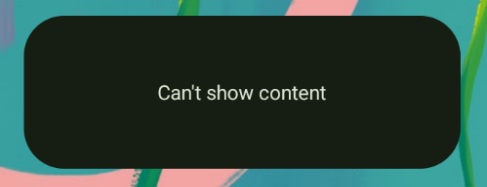API features for improving error handling on Glance are included beginning in Android 15. This page provides best practices regarding these APIs.
Use a try-catch block around non-composable components
Compose doesn't allow try-catch blocks around composables, but lets you wrap your app's other logic in these blocks. This lets you use Compose for your error view, as shown in the following example:
provideContent {
var isError = false;
var data = null
try {
val repository = (context.applicationContext as MyApplication).myRepository
data = repository.loadData()
} catch (e: Exception) {
isError = true;
//handleError
}
if (isError) {
ErrorView()
} else {
Content(data)
}
}
Default error layout
If there is an uncaught exception or a Compose error, Glance displays a default error layout:


Glance lets developers provide an XML layout as a fallback if composition fails. This means that there was an error in the Compose code. This error UI also appears if you have an uncaught error in your app's code.
class UpgradeWidget : GlanceAppWidget(errorUiLayout = R.layout.error_layout)
This layout is a static layout that your user can't interact with, but is good in emergency cases.

Add actions to the default error UI
As of Glance 1.1.0, Glance lets you override the default error handling code. This way, you can add action callbacks in the event of an uncaught exception or error in composition.
To use this feature, override the onCompositionError() function:
GlanceAppWidget.onCompositionError(
context: Context,
glanceId: GlanceId,
appWidgetId: Int,
throwable: Throwable
)
In this function, Glance falls back to the RemoteViews API for error handling.
This lets you specify layouts and action handlers using XML.
The following examples show you, step-by-step, how to create an error UI that includes a button to send feedback:
Write the
error_layout.xmlfile:<LinearLayout xmlns:android="http://schemas.android.com/apk/res/android" style="@style/Widget.MyApplication.AppWidget.Error" android:id="@android:id/background" android:layout_width="match_parent" android:textSize="24sp" android:layout_height="match_parent" android:orientation="vertical"> <TextView android:id="@+id/error_title_view" android:layout_width="match_parent" android:textColor="@color/white" android:textFontWeight="800" android:layout_height="wrap_content" android:text="Example Widget Error" /> <LinearLayout android:layout_width="match_parent" android:orientation="horizontal" android:paddingTop="4dp" android:layout_height="match_parent"> <ImageButton android:layout_width="64dp" android:layout_height="64dp" android:layout_gravity="center" android:tint="@color/white" android:id="@+id/error_icon" android:src="@drawable/heart_broken_fill0_wght400_grad0_opsz24" /> <TextView android:id="@+id/error_text_view" android:layout_width="wrap_content" android:textColor="@color/white" android:layout_height="wrap_content" android:layout_gravity="center" android:padding="8dp" android:textSize="16sp" android:layout_weight="1" android:text="Useful Error Message!" /> </LinearLayout> </LinearLayout>Override the
onCompositionErrorfunction:override fun onCompositionError( context: Context, glanceId: GlanceId, appWidgetId: Int, throwable: Throwable ) { val rv = RemoteViews(context.packageName, R.layout.error_layout) rv.setTextViewText( R.id.error_text_view, "Error was thrown. \nThis is a custom view \nError Message: `${throwable.message}`" ) rv.setOnClickPendingIntent(R.id.error_icon, getErrorIntent(context, throwable)) AppWidgetManager.getInstance(context).updateAppWidget(appWidgetId, rv) }Create a pending intent that references your
GlanceAppWidgetReceiver:private fun getErrorIntent(context: Context, throwable: Throwable): PendingIntent { val intent = Intent(context, UpgradeToHelloWorldPro::class.java) intent.setAction("widgetError") return PendingIntent.getBroadcast(context, 0, intent, PendingIntent.FLAG_IMMUTABLE) }Handle the intent in your
GlanceAppWidgetReceiver:override fun onReceive(context: Context, intent: Intent) { super.onReceive(context, intent) Log.e("ErrorOnClick", "Button was clicked."); }
